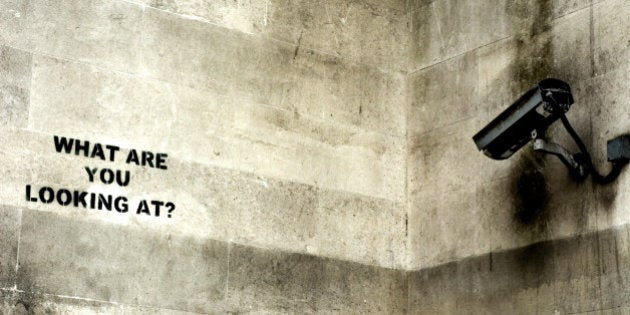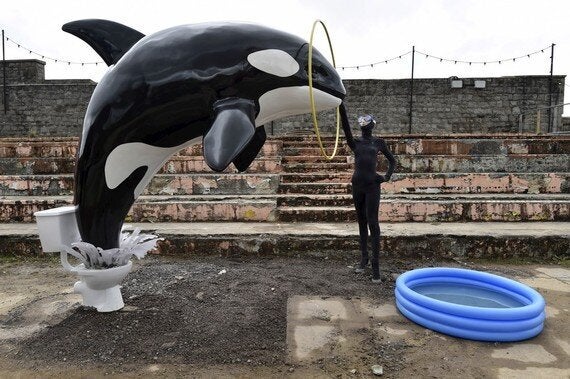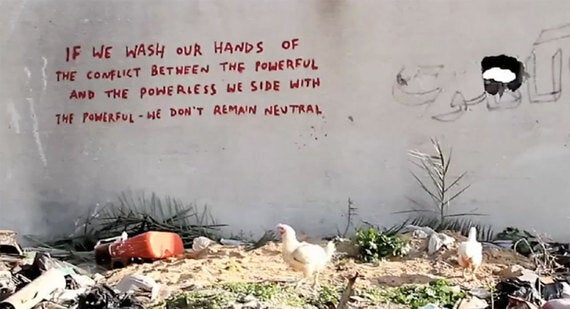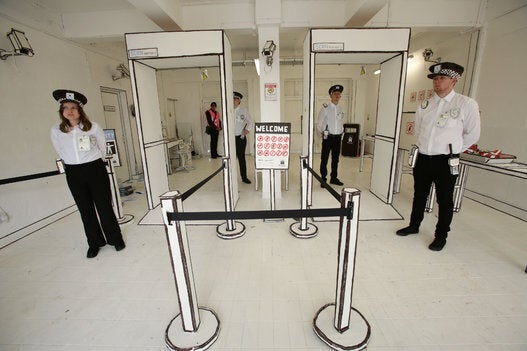
Banksy, the anonymous yet somehow ubiquitous graffiti artist from Bristol, UK, has unveiled his latest project: a dystopian version of Disneyland called "Dismaland" (Dismal Land) -- and it's bad. It's bad, and it's uninteresting.
Everything about Dismaland laments "the world is a terrible place." Personally, I find it difficult to appreciate art that is inherently negative, and the whole installation is reminiscent of Deviantart sketches that have existed for years. Dismaland is a jumble of different messages -- narcissism is bad, says the "Selfie Hole" installation; sensationalizing death is bad, says the piece that shows Cinderella dead with paparazzi surrounding her, reflecting the death of Princess Diana; Sea World is bad, says the sculpture of the orca jumping out of a toilet and through a hoop.

(via Toby Melville for Reuters)
While all these sculptures might be interesting to look at, Banksy's ideas are not innovative. Mike Nudelman put it best in his piece for Business Insider: "Dismaland is, quite literally, art about nothing. Consumerism is bad, Disney is evil, advertising is dishonest - we got it." Banksy is not teaching us anything new.
You are not teaching us anything new. These are very established political messages and they are not original, and yet, whenever new Banksy artwork surreptitiously surfaces on a wall in Bristol or a building in New Orleans, people go nuts.
On top of being unoriginal, Banksy's artwork is not brave. In some cases, it's insensitive. For example, Banksy painted a kitten on the remains of a house in Gaza that had been wrecked by an Israeli air strike. Is it ethical to show up in a community that is suffering due to systematic violence to graffiti a bunch of dilapidated buildings and then leave, for the sake of "art?" Why is it that we feel more inclined to listen when an artist with a white-saviour attitude comes into Gaza with ease, talking over the many indigenous Palestinians who don't have the same mobility? Did Banksy really leave a lasting impression in people's minds about the horrors of the Israel/Palestine conflict by spray-painting a kitten onto a destroyed home?
Instead of going undercover in Gaza to leave his art in places it doesn't belong, Banksy could have made monetary donations to worthwhile charities aiding relief in that region. What it must have cost him to fly there would itself be a valuable amount of money to donate. Instead, he transparently paraphrased the famous Desmond Tutu quote "If you are neutral in situations of injustice, you have chosen the side of the oppressor" and put it up on a wall. Groundbreaking!

(one of Banksy's pieces in his Gaza series, via banksy.co.uk)
Common arguments in favour of Dismaland have pointed out that the exhibition does not feature just Banksy's work, but a lot of other artists. Some of them are other white, wealthy artists like him who don't need the publicity, such as Damien Hirst, but out of the 58 artists whose work will be on display, a handful are from places such as Iran, Palestine, Egypt, and Saudi Arabia, and are significantly less well-known. However, Banksy is still the curator, so while it's good that he has a diverse group of artists contributing to this piece, Dismaland still reflects his own vision and he hand-picked the artists. Dismaland is not collaboration between a group of artists with a concerted message, it's about Banksy and the message that he wants to get across.
So, between imagery of dead princesses and orcas jumping out of toilets and aggressively timeworn political messages, where does Banksy draw the line with protest art? Palestinian artist Shadi Alzaqzouq was kicked out of Dismaland for protesting Israeli artists, one of whom was part of the Israeli Defense Forces, who were also part of the exhibition. All Alzaqzouq did was cover up his paintings with bed-sheets that read "R.I.P Gaza, boycott Israel" but he was told his protest was too ugly. Yes, a peaceful protest with important political significance was too ugly for the ugliest and most politically charged theme park in the world.

(Shadi Alzaqzouq's protest piece, via The Jewish Chronicle)
There is another side to Banksy's success that many of his fans don't address -- that he can spray-paint walls with impunity simply because it is widely assumed that he is white. Graffiti art is almost always seen as vandalism because it is the chosen avenue of self-expression of poor brown and black "thugs," but whenever Banksy spray-paints a wall, it is revolutionary. Granted, a lot of street art does not carry political messages, but a lot of it is meant to evoke the same emotions and reactions that Banksy's art brings forth.
In 2013, 18 year-old Latino artist and skateboarder Israel Hernandez was shot dead by police for tagging a wall. Twenty-one-year-old Delbert "Demz" Rodriguez was pursued and hit by an unmarked police cruiser by local cops who chased him for tagging a wall just a few blocks away from where Hernandez was killed. Rodriguez died from his injuries. Earlier this year, 19 year-old Hector Morejon was killed for the same reason. Yes, graffiti art is illegal, but the question is worth posing -- could Banksy stay anonymous if we knew he was a man of colour? The fact is that there are incredibly talented street artists of colour who do not get the recognition they deserve because they are stereotyped and cast aside by elitists in the art community.
Banksy's work might have held credibility when he really was just a subversive, unknown graffiti artist, but now, his art is predictable. Now that Banksy is a globally-recognized brand, his mild, banal anti-establishment messages ring as hypocritical (and easy to make fun of) because he benefits enormously from that very establishment. This is not to say that fighting consumerism and capitalism isn't a worthwhile cause. This is also not to say that people should stop making art when they become famous, or that artists should not make money from their efforts, because of course they are deserving of being able to live off their art; however, Banksy's Dismaland is just not that great.
People love Banksy because the messages that his art conveys are easily accessible to the type of person who wants to seem deep but doesn't want to put in the effort. Art is not really revolutionary if it is so easily consumed. Art is not revolutionary if it is absorbed by people patting themselves on the back without any self-reflection. I might be able to give Banksy props for the aesthetic value of some of the sculptures at Dismaland, but Dismaland itself doesn't hold merit as a good political art piece. Everything about Dismaland is overshadowed by an incredibly pretentious and diluted "the system sucks" message. Yeah Banksy, the system sucks, we know... so what? What's next?
ALSO ON HUFFPOST:
